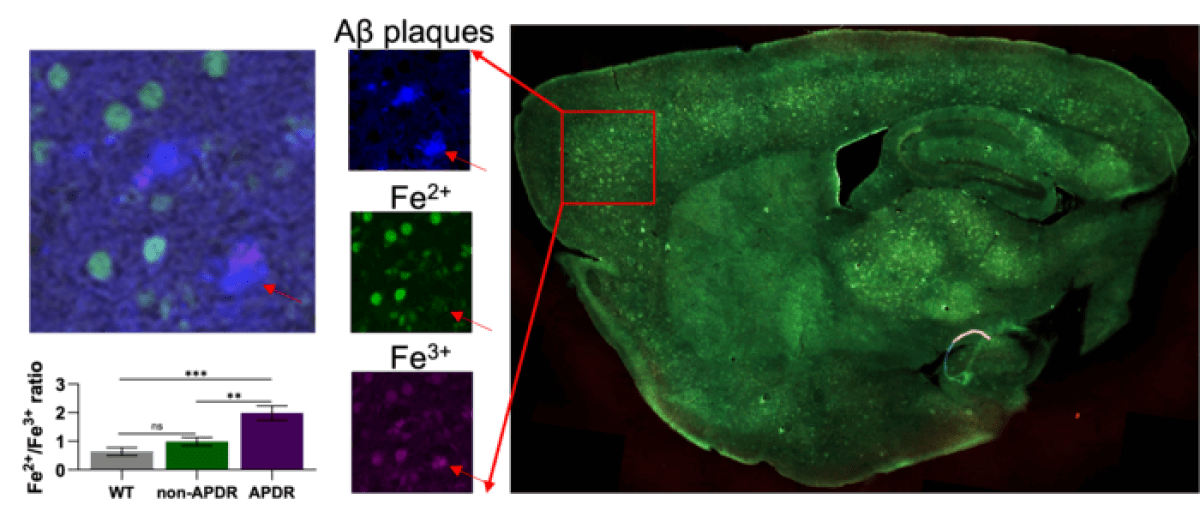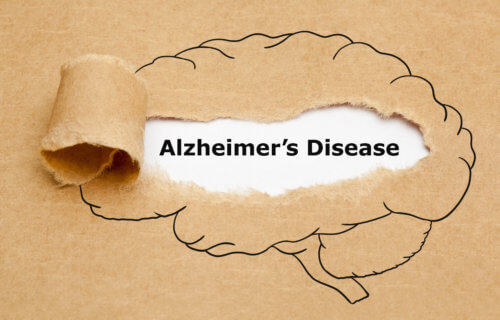AUSTIN, Texas — Modern medicine has long believed that the abnormal buildup of amyloid beta plaque in the brain is likely the main cause of Alzheimer’s, the most common form of dementia. However, more and more evidence in recent years suggests that iron in the brain may play a significant role in Alzheimer’s disease development as well. Now, for the first time ever, a new study is revealing that within the very same regions of the brain where the amyloid beta plaques linked to Alzheimer’s gather, there is also an increase in iron redox. That means the iron in these regions is more reactive when in the presence of oxygen.
The research team, including scientists from both The University of Texas at Austin and the University of Illinois at Urbana-Champaign, believe their findings may produce even more details regarding the underlying causes of Alzheimer’s, as well as aid in the search for new drugs to treat the neurodegenerative disease.
“The link between iron redox and Alzheimer’s disease has been a black box,” says Yi Lu, corresponding author and professor of chemistry at UT Austin, in a media release. “The most exciting part to me is that we now have a way to shine light into this black box so that we can begin to understand this whole process in much more detail.”
Roughly a decade ago, scientists uncovered that ferroptosis (a bodily process dependent on elevated iron levels) leads to cell death and plays a key role in neurodegenerative diseases like Alzheimer’s. By performing magnetic resonance imaging (MRI) scans on living Alzheimer’s patients, researchers observed that these patients tend to display higher iron levels in their brains. It’s important to note, however, that those methods did not allow for the distinction between different forms of iron. Taken together, these findings indicate iron plays a notable role in the destruction of brain cells in Alzheimer’s patients.

For this latest research, study authors put together DNA-based fluorescent sensors capable of detecting two different forms of iron (Fe2+ and Fe3+) at the same time among both cell cultures and in brain slices taken from mice genetically modified to mimic Alzheimer’s. One of the sensors glows green for Fe2+ while the other glows red for Fe3+. This new approach is the first imaging technique capable of simultaneously detecting both forms of iron in cells and tissue, while indicating their quantity and spatial distribution at the same time.
“The best part about our sensor is that we can now visualize the changes of Fe2+ and Fe3+ and their ratios in each location,” explains Yuting Wu, a co-first author of the study and a postdoctoral researcher in Lu’s lab at UT Austin. “We can change one parameter at a time to see if it changes the plaques or the oxidative states of iron.”
That ability may help researchers form a clearer understanding of why there is an increased ratio of Fe3+ to Fe2+ in the location of amyloid beta plaques, as well as whether or not increased iron redox plays a role in forming the plaques.
Yet another big question is whether or not the iron redox directly contributes to Alzheimer’s cell death or is just a byproduct. Researchers are set to explore this question in Alzheimer’s mice. If future research finds iron and its redox changes indeed cause cell death in Alzheimer’s patients, those findings could facilitate a potential new strategy for drug development. More specifically, perhaps a drug that changes the ratio Fe3+ to Fe2+ could help protect brain cells. The new imaging probe could test how efficiently drug candidates work at changing the ratio.
To develop the sensors, study authors hired a commercial lab to produce a library of 100 trillion short DNA strands, using a chemical process called oligonucleotide synthesis. Next, scientists conducted a screening process aimed at finding strands that recognize — or in chemistry terms, “bind tightly to and conduct a catalytic reaction with” — a specific form of iron and no other forms. Finally, to complete the sensors, researchers added additional components including molecules called fluorophores that glow in a specific color when the probe recognizes the particular form of iron.
The study is published in Science Advances.
What is Alzheimer’s disease?
Alzheimer’s disease is a chronic and progressive brain disorder that affects memory, thinking, and behavior. It is the most common form of dementia, a condition characterized by a decline in cognitive function and memory loss.
The disease usually begins with mild symptoms, such as forgetfulness, difficulty remembering recent events, and problems with language. As the disease progresses, the symptoms become more severe, and individuals may experience changes in personality and behavior, confusion, difficulty with communication, and eventually, loss of independence.

– stock.adobe.com)
Until now, scientists have believed that Alzheimer’s is mainly the result of a buildup of abnormal proteins in the brain, including beta-amyloid and tau proteins. These proteins form plaques and tangles, which disrupt the normal communication between brain cells, leading to the death of brain cells and the shrinking of the brain.
Although there is no cure for Alzheimer’s disease, there are treatments available that can help to manage the symptoms and improve quality of life for individuals with the disease. These treatments include medications to help manage symptoms such as memory loss and behavioral changes, as well as lifestyle changes such as regular exercise, a healthy diet, and social engagement. Additionally, research is ongoing to develop new treatments that can slow or stop the progression of the disease.

